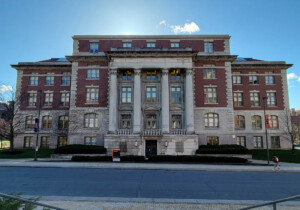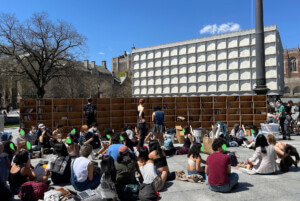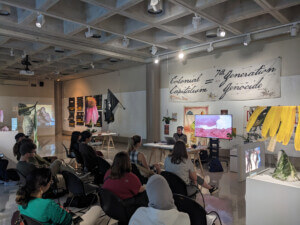It’s the start of the 2023–24 academic year, so that means a new crop of leaders are beginning the semester. To check in, AN spoke with a set of leading educators about their roles. Each answered a septet of questions; the first in this series is Julia Czerniak, Professor and Dean at University at Buffalo School of Architecture and Planning.
What are your goals and ambitions for your new role?
I see a deanship as a leadership position with a disciplinary project that engages, inspires, supports, and advocates for the school, university and city. Buffalo has a rich culture of architecture, landscape and planning that spans centuries—from design work by Louis Sullivan, H. H. Richardson, Frank Lloyd Wright and Frederick Law Olmsted to, most recently, OMA and Walter Hood. With such a legacy within which to situate an ambition, I want to build a school of creative, talented, and intelligent people who discuss provocative ideas, do meaningful work, and collectively advance timely and serious projects to not only show what we as architects and planners can do, but also how we, in the context of deindustrializing Buffalo, can get things done. In other words, by building both relationships and projects.
One of the things that attracted me to the School of Architecture and Planning at the University at Buffalo (SAP) is the school’s rich multidisciplinary environment, which, in my experience, is not only urgent as design education interfaces with the complex issues of the 21st century, but necessary as the cross-fertilization of expertise breeds fresh and innovative thinking. I look forward to working with the faculty on imagining the possibilities landscape architecture can bring to the existing disciplinary mix of architecture, planning, real estate, and historic preservation in the school. And Buffalo, as a climate refuge city, is a fantastic environment in which to experiment. The SAP has an incredible legacy of creative making and engaged learning, and my role is to build and share the innovation of what we do to strengthen its reach and impact.
Who is someone who has inspired your work and leadership? Why are they inspirational?
It’s impossible to name one person, as inspiration comes in many forms. James Corner was certainly formative in my early career, and I was drawn to his incredible ability to—all at once—design, write, practice, and theorize. Transdisciplinary thinkers and doers such as Nina-Marie Lister continue to be instrumental to my own work, especially in relationship to ecology, climate resilience and biodiversity as it intersects with design and planning.
Sarah Whiting and Sylvia Lavin were strong female role models during my graduate studies at Princeton, and witnessing their abilities—intellectually, interpersonally, and strategically as they built their academic careers—was empowering. Both, of course, later became chairs of their departments and deans of schools. More recently at Syracuse, the way that former dean Mark Robbins navigated and current dean Michael Speaks navigates the landscape of higher education was remarkable. They both made the work being done in the architecture school understood, visible, valued, and instrumental across the university, from the chancellor’s and provost’s offices to facility services.
My partner, Mark Linder, has modeled—despite all the challenges one faces in architectural education—staying true to one’s aspirations and convictions while thoughtfully and ethically navigating the collective of a community. Remembering this is incredibly important to any incoming dean.
What are the most urgent topics and challenges for architectural education today?
What is so wonderful about the design disciplines is that they are, at once, intellectual projects, social and material practices, and agents of change. A design education moves between knowledge in the STEM disciplines, the humanities, and the arts and it enables our students to think critically, design creatively, problem solve collaboratively, communicate verbally and visually, and be future leaders.
However, it is increasingly difficult for faculty to balance teaching students how to think, how to make, and how to communicate the value and impact of what we do, as well as address the environmental and social complexities of the 21st century. How we educate students in our fast moving, information saturated, and ever-expanding field is an ongoing challenge. Students are eager to problem solve, but finding the balance in educational models between teaching architecture’s “internalities” (disciplinary knowledge, design skills, professional tools and competencies) and engaging its “externalities” (issues in our world, from climate crises to inequities of all kinds) is essential.
Attention to and activism for social justice and equity will continue to inspire us to re-examine what we teach, how we teach it, and by whom. This is one of the greatest challenges that design education faces moving forward.
How has the COVID-19 pandemic changed your thinking about being a leader in higher education, if it has?
The COVID-19 pandemic has taught us that crises can happen quickly and—despite enormous challenges—catalyze exciting change. We felt the challenges of shifting course delivery modes broadly across the university community: For faculty, the enormous effort of this transition has happened at the expense of research and creative work; for students, the loss of transformative years of college life has exacted a toll on their personal growth; for staff, balancing home schooling while working has erased work/life balance; for the university, the loss of significant revenue streams from housing, food service and sports events has broad fiscal implications.
Nevertheless, most of us have experienced positive outcomes from these transitions and technologies that not only address these concerns but open exciting future possibilities. I am thrilled to see how faculty have expanded their classrooms to include national and international colleagues and developed their networks, catalyzing new alliances for research and creative work. It was remarkable how we were able to shift entire curriculums online by experimenting with tools and emerging technologies. Now, hybrid courses have enabled us to rethink course structures and imagine new online programs that can reach more diverse audiences and enable equitable student access, while bringing in missing expertise to the school.
Moving ahead, I look forward to thoughtful discussions about the entangled issues of future teaching and learning modalities that will engage not only educational benefits and pedagogic possibilities, but also issues of economics, equity, and politics.
How should the topic of sustainability be incorporated into architectural education?
Sustainable strategies and practices for cities, landscapes, and buildings have been infiltrating design education for quite some time. A more recent change I’ve noticed is the elevation of expertise that PhDs in building science are bringing to the classroom. Their research, as well as the tools and technologies they work with, expose students to more sophisticated ways to, for example, model energy, simulate runoff and erosion, or measure municipal waste. It will be interesting to see the alliances of our faculty’s work with UB’s robust climate action plan that strives for carbon neutrality by 2030.
As important as it is to continue such efforts, the Anthropocentric entanglement of human systems with planetary ones demands critical reflection. Some classes in sustainability should examine, through theoretical and historical lenses, human–nature relationships and the ideological clashes and value systems that are embedded in architecture and the built environment to catalyze new possibilities.
However, designing sustainably is not enough. (Or perhaps its strategies are proving to be too little too late.) As this summer has shown through its deadly heatwaves, flash flooding, and drifting wildfire smoke, architectural and design educators must think more about how human and non-human species adapt to a warming earth and become resilient to constant change, some extreme. How do cities, buildings, landscapes, and infrastructure respond? How do we live differently?
How should the goals of diversity and inclusivity be advanced under your leadership?
Building a culture of inclusion within the academy happens at many scales—from the university to the school to the individual—and is an ongoing commitment and investment. Many of us have experienced the policies and strategies enacted by universities that are important and will continue.
My efforts reflect the belief that diversity and inclusion are not ends in themselves, but means to achieve institutional aspirations. Diversifying our student body is just a first step. We must work hard to engage and celebrate what a diverse community brings to the school and to the education of planning and design professionals. As our student population diversifies, so should our priorities for faculty hires, as one important way that students can see themselves in our fields is to see it in others. A design education is also enriched by the coexistence of multiple pedagogies, perspectives, and practices. This value is continuously reinforced by supporting a wide range of faculty interests and expertise.
Examining what we teach, how we teach it, and by whom is one of the greatest challenges that design education faces moving forward, and there are many questions that should drive this discussion, such as: What is missing from our discipline’s curriculum? Can we imagine alternative pedagogies that more directly engage issues of diversity? How do we converse with faculty to reveal how the complexities and nuances of “diversity” appear in both their syllabi and their classrooms? What incremental steps catalyze larger investment?
What are you optimistic about as you create the future of architecture and architectural education?
Architectural education is a project of hope. Giving hope to the next generation means teaching that the knowledge and skills that an architectural, landscape and planning education gives students matter, regardless of where they choose to position their careers within a disciplinary map—from the technical to the theoretical. Educators have a role to play in combatting eco-anxiety by imaginatively engaging with these overwhelming issues and by showing and sharing the impact of architecture’s innovations.
I recently had two opportunities where I learned an enormous amount and now have a better grasp of this aspiration. The first is a recent studio I co-taught as part of the Envision Resilience Challenge, where students learned—despite alarming predictions of sea-level rise—that strategies of retreat allowed them to imagine brighter futures where denser land use, novel historic preservation strategies, alternative social living arrangements, and clean energy sources allowed for the thriving of both human and non-human populations. Others used retreat to give land back to Indigenous tribes as one strategy of decolonization. In other words, retreat provided an opportunity to right a lot of past wrongs.
In June I returned from co-teaching a field studies course in the Galapagos Islands on the relationship of biodiversity to design through reimagining simple systems of infrastructure—sea walls, road crossings, shade structures—for multiple species, not just people. The outcome from that three-week field course could not have been better as students departed the islands with an entirely new way of seeing not only our discipline, but our world, a more-than-human world.
What we do is imagine futures. Can you get more optimistic than that?











